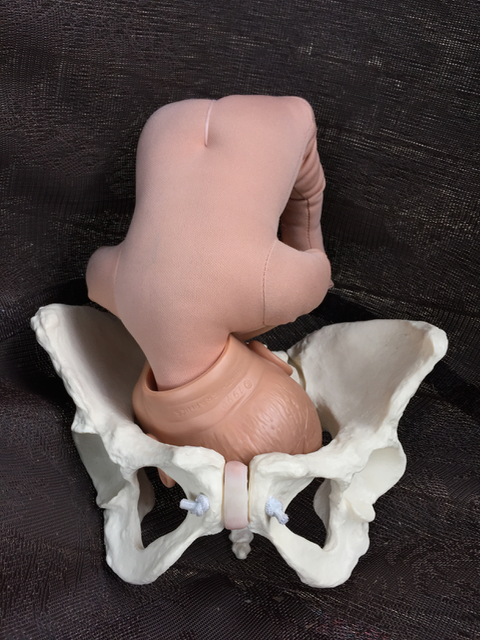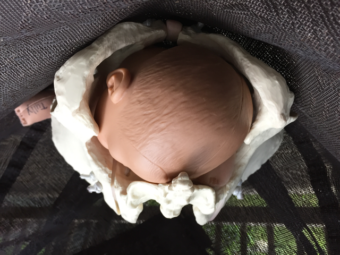
Asynclitism means asymmetrical. It’s when a baby’s head is tipped towards one shoulder. The tipped head has a harder time passing through the narrow part of the pelvis, the ischial spines. Labor becomes longer, and sometimes the baby doesn’t fit out the pelvis. Happily, we have techniques for this problem!
Early in labor, the baby’s head enters the brim of the pelvis in asynclitism, tipped, to get around the protruding base of the spine (sacral promontory). Early in labor, before 3 cm, asynclitism is normal and desired.
At 3 cm, when the nurse checks the cervix, she’ll notice that the baby’s head is closer to the mother’s front (usually). There is space between the baby’s head and the mother’s sacrum in back. We are reassured, as long as the forehead doesn’t overlap the pubic bone (in which case, we help the baby engage in labor).
By 4-5 cm, the head has usually filled in the space in the pelvis evenly. There will be more room in the back, but the side to side angles of the head match. The head has become symmetrical inside the pelvic canal. The head is synclitic.
Asynclitism becomes a problem when the head is still tipped at, and after, 5 cm dilation.




The nurse, doctor, or midwife may notice the asynclitism during a vaginal exam. The cervix will be thicker on one side and thinner on the other side
NOTE: thicker in front is normal, in my experience, and I don’t worry too much about that). The baby’s head will seem a little lower and closer to the bones on the thin side. The baby’s head will seem to angle away, deeper into the pelvis and less close to the mother’s bones on the thick side. The nurse will have to think about it, so ask her to check for this before or during the vaginal exam.
If the bag of water releases suddenly with a strong contraction, there is a possibility that the baby’s head comes down to the mid-pelvis while still asynclitic. Asynclitism may be caused by a hand near the face, or if muscles are imbalanced, a twist in the lower uterine segment, causing the baby to twist to fit the area. More typically, the pelvic floor is asymmetrical and so the head gets tipped as it is pressed down with strong contractions on the uneven edges of the opening to the pelvic floor.
Labor is often longer. Sometimes the labor pattern is a fast dilation to about 8 cm and then slow to get to 10 cm. Other times, when a hand is up, things may be slow throughout dilation. Pushing tends to go very slow – the baby can’t help get born in this position. The head is angled wide and the baby can’t wiggle down because the neck isn’t lined up with the spine. Mom has to do the work. Dilation often takes longer and there can be a delay in progress at about 8-9 cm or 9 1/2 centimeters for many hours. A mother may feel pain to one side. She may have significant pain in one hip. Hip pain may also be from one of the baby’s arms being up along the head or a spasm in the muscles within the broad ligament. Contractions are often strong throughout, unlike the ebb and surge of posterior labor (though that can happen, too).
It not unusual for the second stage to last 3-6 hours when the head is tipped. I’ve also attended first-time mothers with second stages 2 and 3 times longer than this. The baby can develop a caput. This doesn’t necessarily mean that the baby won’t fit. Often, the baby requires the mother to change position frequently (maternal positioning) to open the pelvis. Spinning Babies pays attention to the “soft tissue” anatomy (muscles, fascia, ligaments) in the mid-pelvis and muscles to the pelvis.
Eating small amounts and drinking warm honey tea helps keep labor contractions strong enough to keep moving the baby. Lying down in one position is not likely to allow the baby to descend further downward. Very specific and persistent techniques are often necessary. As long as we are talking about what to do, please look into craniosacral therapy and pediatric chiropractic for the baby after birth. They should know the special techniques for babies. This can be very helpful with the breastfeeding latch.
Sometimes the doctor will want to use a vacuum (ventouse) or forceps during a contraction to pull the head out. There are some risks, of course, but if the head is low enough, attempting to continue with a vaginal birth avoids the risks of major surgery to the woman herself. Sometimes, a birthing woman simply needs more time to let the baby come down. An attendant with the unique skills of supporting the long labor naturally is becoming a rare bird. More than just postponing a cesarean, skills for natural labor includes knowing how to help a mother continue to labor without physical or emotional trauma. Of course, one of those skills is knowing when enough is enough. A cesarean is meant to be a lifesaver, not a lifestyle.
There is a dance the midwife does between forces of inertia and forces of birth. Knowing when to eat, when to rest and when to work the pelvis is vitally important when labor is long and the second stage even longer. A doula, or two, can mean the difference between vaginal birth and surgery. Her talents in emotional support may find themselves calming the nurses and providers. The mother needs to want to continue the birth. After a particularly difficult birth, we want to know that she is joyous and not second-guessing herself. The birth team may need to get together to discuss the birth.
In labor, if the mother decides enough is enough, the support team must seriously consider their options for finishing the birth. With a birth team that works well together and a willing mother, many mothers will persevere to finish the birth themselves. They will feel proud and maybe a bit confused as to why their labor was so difficult. What we don’t want is to have the mother feel like she was suffering. Listen to the mother and let her lead. Give encouragement while leaving an opening for her to lay down her hand. There is a story of asynclitic posterior labor at the end of our page called Side-lying Release. The baby in this story had its chin extended, but was born at home in good health. Asynclitism might repeat in a future birth, but often it does not.
For additional education to even further enhance your pregnancy and labor preparation, shop our extensive collection of digital downloads, videos, DVDs, workbooks, and more.